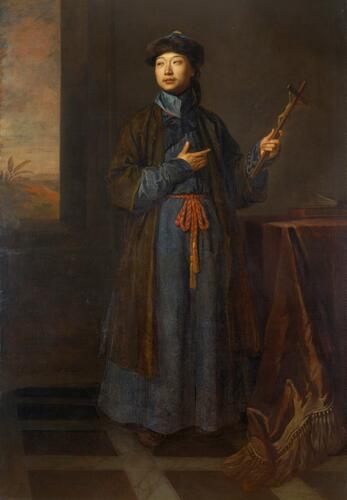-
1 of 253523 objects
Michael Alphonsus Shen Fu-Tsung (d. 1691) Signed and dated 1687
Oil on canvas | 212.2 x 147.6 cm (support, canvas/panel/stretcher external) | RCIN 405666
-
Michael Alphonsus Shen Fuzong (or Fu-Tsung; c.1658–91) was from Nanking, born of Chinese parents who converted to Christianity. He travelled to Europe with a Flemish Jesuit, Father Philippe Couplet, leaving Macao in December 1681 and reaching Paris in 1684, where they had an audience with Louis XIV at Versailles. They went on to Rome in 1685 and had an audience with Pope Innocent XI (1611–89) before returning to Paris. Shen arrived in England in March 1687 and soon became a well-known figure at James II's court.
The king commissioned this portrait from Kneller shortly after his arrival. He is depicted in Chinese robes, holding a crucifix and looking towards the window as the light illuminates his face, suggesting divine inspiration. The naval surgeon, James Yonge, saw Shen at Windsor in July 1687, describing him as 'a young, pale-faced fellow who had travelled from his country and become a papist (his picture being done very well like him in one of the King's lodgings)'. Shen was at the Bodleian Library in Oxford during the summer of 1687, helping the Librarian, Thomas Hyde, to catalogue and translate the Chinese books and manuscripts; when the king visited in September he asked after Shen and remarked that 'he had his picture to the life hanging in his roome next to the bed chamber'. Shen left England in 1688 for Lisbon, where he entered the Society of Jesus as a novice. He died near Mozambique in 1691, on his return to China.
Kneller was born in Lubeck, studied with Rembrandt in Amsterdam and by 1676 was working in England as a fashionable portrait painter. He painted seven British monarchs (Charles II, James II, William III, Mary II, Anne, George I and George II), though his portraits of Charles II are not longer in the collection, and in 1715 was the first artist to be made a Baronet (the next was John Everett Millais in 1885). A set of portraits of naval heroes was given by George IV to the Royal Naval Hospital in Greenwich in 1824.
The painting can be categorised as both a religious image and as a portrait. The composition succeeds on the basis of the unaffected sense of design and the directness of the characterisation. The fact that the sitter looks upwards away from the viewer suggests divine inspiration. According to Horace Walpole, 'Of all his works, Sir Godfrey was most proud of the converted Chinese at Windsor'.
Text adapted from Charles II; Art and Power, London, 2017.Provenance
Painted for James II; recorded in the King's Presence Chamber below stairs at Windsor Castle in 1688 (no 1092); in the King's Drawing Room at Windsor in 1710 (no 12), where it still appears as the over-mantle in Pyne's Royal Residences of 1819 (RCIN 922107).
-
Medium and techniques
Oil on canvas
Measurements
212.2 x 147.6 cm (support, canvas/panel/stretcher external)
232.7 x 169.9 x 6.8 cm (frame, external)
Category
Object type(s)
Other number(s)
Alternative title(s)
The Chinese Convert [Historic title]
"Francis Couplet, a Chinese Missionary," previously called
Father Philip Couplet, previously identified as
